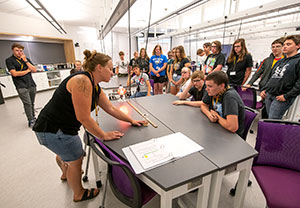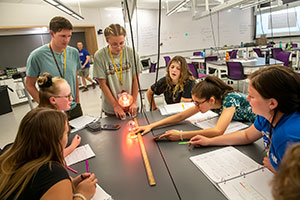Students Study What Makes Planets Habitable at UWs Teton STEM Academy
Published July 14, 2021

Twenty-five high school students from across Wyoming and one from Colorado worked in teams to determine whether planets near different-colored stars could actually be habitable. To help make that determination, the students participated in an experiment using radiometers, which measure light, to record the outer and inner limits of habitability around different types of stars.
The activity was part of the Teton STEM Academy taking place through July 18 on the University of Wyoming campus. The nine-day event offers hands-on activities in the interdisciplinary sciences, including life sciences, physical sciences, engineering and math, all covered under a general theme of planning a journey to Mars.
“Science has always been an interest of mine. I like to find out how things work,” says Brett Pettibone, a student at Lander Valley High School. “Astronomy has always been my favorite of the sciences.”
Mackenzie Jones, who will be a junior at Lyman High School this fall, has been part of a STEM (science, technology, engineering and mathematics) club since she was in sixth grade. When she learned of the Teton STEM Academy, she saw it as a great opportunity. Jones says she has already learned something interesting.
“I learned that Mars has blue sunsets and sunrises,” she says. “At midsunrise on Mars, if Earth is lined up just right, you can see Earth from Mars.”
“We want these kids to see scientists as people who solve important problems,” says Chip Kobulnicky, a professor in the UW Department of Physics and Astronomy, and co-director of the Teton STEM Academy. “We’ve relied on scientists to solve COVID problems or climate disasters.”
Chelsea Lund, a teacher at Black Butte High School in Rock Springs, led a “Mars Base Design” lab July 12 in UW’s Enzi STEM Facility. During the exercise, the students used radiometers to measure light from stars to determine whether planets near the stars could be classified as habitable zones.
Using a ruler, the students measured, in centimeters, the distance from various stars to their planets. As light hit the radiometer, it began to spin. Five rotations in 10 seconds determined the outer limit of a habitable zone, while 10 rotations in 10 seconds defined the inner limit.

“The habitable zone also is called the ‘Goldilocks Zone,’” Lund says. “Not too hot and not too cold.”
Diego Diaz, of Casper, surmised that Europa, one of Jupiter’s four large Galilean moons, was a good candidate for hosting life. He referenced the moon has an ocean and volcanic activity under the water body.
Campers, entering ninth through 11th grades this fall, were chosen based on demonstrated interest and academic potential in math, science, astronomy and space. The camp also includes trips to the Snowy Range near Laramie and to the large research telescope at the Wyoming Infrared Observatory on Jelm Mountain.
“I’m really excited about the hike,” says Isabelle Lobingier, who will be a freshman this fall at Powell High School. “We’ll be doing soil and water testing -- growing bacteria.”
Professional astronomers; UW graduate students majoring in astronomy or education; and high school and junior high school teachers are leading the week’s activities.
In 2018, an anonymous donor from Teton County made a three-year, $150,000 commitment to the Teton STEM Academy, formerly known as the ExxonMobil Bernard Harris Summer Science Camp that ran from 2010-15 on UW’s campus before funding dried up.
“Inspiring young people like this is the most important thing I do all year,” Kobulnicky says. “Camps like this show good results for recruiting to UW or other colleges. These students have a distinct interest in the STEM fields, which we hope to cultivate.”
Teton STEM Academy attendees, listed by hometown, are:
Brighton, Colo. -- Dylan Leonard.
Casper -- Jake Boatman, Diego Diaz, Madeline Elston, Andrew Gruner, Kira Lester, Tori Lester and Stella Wayte.
Cheyenne -- Solomon Moritz and Brayden Neville.
Lander -- David Binns, Brett Pettibone and Randall Wise.
Laramie -- Joseph Coast, Julia Gatlin, Joseph Lindley, Selma Piri and Kat Shupe.
Lyman -- Mackenzie Jones.
Jackson -- Parker Harris.
Kemmerer -- Ryan Carroll.
Powell -- Isabelle Lobingier.
Riverton -- Samantha DeClercq.
Rock River -- Lexi Mainardis.
Rock Springs -- Jaysha Chavez.
Sheridan -- Joseph Harper.

